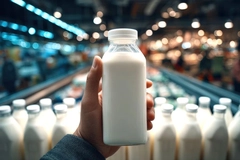Yangi launches Swedish collaboration to discover new bio-based barrier chemistry

10 Oct 2022 --- Swedish startup Yangi is entering a research collaboration project to accelerate the shift from fossil-based plastic packaging toward bio-based alternatives. The goal of the collaboration is to understand and develop new barrier chemistry and methods for the formation of fiber-based packaging related to dry-forming and wet-molding technologies.
Project partners include Holmen Iggesund, Solenis, Fiber-X, FutureLab & Partners AB, Duni Group, KTH Royal Institute of Technology, Lund University in Sweden and a premium brand owner within the consumer goods segment.
“Compared to other bioplastic applications, our solution uses readily available materials, cellulose, intending to be either recyclable in a paper stream or compostable. The advantage of being able to use paper recycling is the high capacity and current capabilities compared to bioplastic, which may contaminate traditional plastic recycling streams,” Adam Johansson, senior development engineer at Yangi, tells PackagingInsights.
“The Yangi technology is resource efficient, both from an energy and a water perspective and both these result in minimizing CO2 equivalent emission.”
Yangi manufactures machines for the dry forming of cellulose fibers into various types of recyclable packaging, with the goal to replace single-use plastics and push the packaging industry to become more environmentally sustainable.
The company claims its technology is new and makes it possible to go from cellulose pulp to finished packaging in one machine line using no added water.
.jpg) Yangi says the wider aim of the project is to achieve 100% bio-based packaging without losing product qualities.Maintaining qualities
Yangi says the wider aim of the project is to achieve 100% bio-based packaging without losing product qualities.Maintaining qualities
Yangi says the wider aim of the project is to achieve 100% bio-based packaging without losing product qualities that can satisfy the rising demand for circularity and recyclability. Other aspects to be considered when aiming to achieve optimal packaging quality are resource efficiency, attractive design, formability as well as rigidity and 3D-format, according to the company.
“The project has started the first phase now and is planned to end at the beginning of 2025,” says Johansson.
The consortium is represented by actors from the packaging value chain, including brand owners from Sweden and Europe, raw material and chemical suppliers, manufacturers, and technology developers for cellulose-based packaging for wet molding and dry forming.
“One of the biggest challenges we are expecting is meeting the barrier and functional chemistry requirements with a 100 % bio-based solution. The fiber-based raw material is by nature 100% bio-based, but functionality, in the means of mechanical and barrier properties needs to be incorporated to add more value to the finished product,” explains Johansson.
Relatedly, Nereid Biomaterials, a team of material scientists, microbiologists, and oceanographers working to develop biodegradable materials for the ocean, recently highlighted that plastic’s affordability, adaptability and durability is “unparalleled and unquestioned.”
Better than bioplastic?
Johansson wants to find viable alternatives to plastic by looking further than what is readily available on the market and by exploring new grounds, challenges are expected. “And with the knowledge of these challenges, the project consortium is built up by partners with broad knowledge and extensive industrial experience with fiber-based materials.”
“There is also the current issue of the supply of bioplastic solutions. We see that it is important to find the right solution for each application, different solutions may fit better in different applications, and there are opportunities to work together to develop solutions for a fossil-free, circular future,” asserts Johansson.
However, US President Joe Biden recently gave an executive order to advance American biotechnology and biomanufacturing. New initiatives and funding will boost the bioplastics market – part of the government’s efforts to reduce carbon emissions, lower prices, strengthen supply chains and promote energy security.
By Natalie Schwertheim











